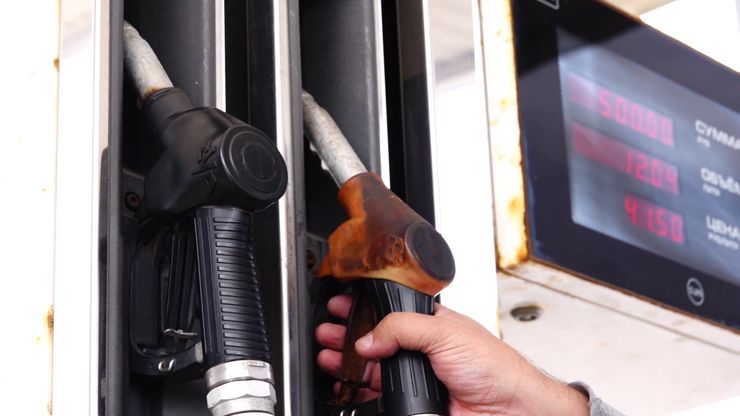The crazy jump in exchange rates against the Russian ruble diverted citizens’ attention from the accelerated change of price tags at gas stations. But this will not last long: already in September motorists will have every reason to cry from the consequences of the activities of the authorities and oil tycoons.
Well, is everyone already used to 50 rubles per liter of AI-92? But until recently, you could buy a similar amount of AI-95 for such a price. But will it still be! Analysts nod that demand for fuel is greater than supply. But in fact it is an effect, not a cause. Greater demand was created by fuel wholesalers, who buy it on the St. Petersburg Stock Exchange and ship it abroad instead of selling it within Russia. The authorities, represented by the Ministry of Energy, are only discussing the creation of some kind of mechanism to prevent the “leakage” of fuel from the country’s market.
Meanwhile, another government decree will come into force from September 1, which will certainly lead to an increase in the price of fuel at gas stations. We are talking about reducing payments from the budget to oil companies under the so-called “damper”. Recall that it consists of budget transfers from the Treasury in exchange for companies not raising retail prices at gas stations. As you can see, the deal is not being executed very well: petrol and diesel have risen in price since the beginning of the year. And this despite the fact that since January 2023, according to the Ministry of Finance, the state has transferred a total of 653 billion rubles to the leaders of the fuel market – as part of the damper plan described above.
In September, these deductions will be halved. There is no doubt that the oil industry will immediately shift the burden of “lost revenue” onto the wallets of car owners. Do you know how the Ministry of Finance thinks in this situation? Not at all about the problems of citizens.
He thinks of budget revenue, shielded from the current state of the economy of the country as a whole! The ministry is boldly planning to slightly increase the export tax on the export of oil and oil products. That is, deductions for commercial gasoline exports will increase by $1.4 – to $6.4 per ton. The state receives about 140 rubles more from the exporter for every 1000 kg of gasoline. What a decisive move, damn it! Especially when you consider that at the St. Petersburg Stock Exchange a ton of AI-92 costs 62,000 rubles. Against this background, the levy that has grown into the “cosmic” 640 rubles will in principle not be able to influence the situation.
Measures that can radically solve the problem of filling the country’s domestic market with fuel and lowering retail prices are known. This is an increase in the norm for the mandatory sale of fuel on the St. Petersburg Stock Exchange to at least 25% of the total volume of its output by oil refineries. It was recently raised cautiously from 12% to 13%. Of course, this step did not really affect the situation.
The second lever to cool the hype among gasoline exporters could not be symbolic, as is the case now, but a really noticeable increase in excise duty: not by a ridiculous 140 rubles, but at least up to 1,500 rubles per ton of fuel . But nothing of the kind is being done or even discussed by the authorities. At least in public. As a result, on September 1, we not only see students who have moved to the next class, but also price tags at gas stations that have had a low start
Well, is everyone already used to 50 rubles per liter of AI-92? But until recently, you could buy a similar amount of AI-95 for such a price. But will it still be! Analysts nod that demand for fuel is greater than supply. But in fact it is an effect, not a cause. Greater demand was created by fuel wholesalers, who buy it on the St. Petersburg Stock Exchange and ship it abroad instead of selling it within Russia. The authorities, represented by the Ministry of Energy, are only discussing the creation of some kind of mechanism to prevent the “leakage” of fuel from the country’s market.
Meanwhile, another government decree will come into force from September 1, which will certainly lead to an increase in the price of fuel at gas stations. We are talking about reducing payments from the budget to oil companies under the so-called “damper”. Recall that it consists of budget transfers from the Treasury in exchange for companies not raising retail prices at gas stations. As you can see, the deal is not being executed very well: petrol and diesel have risen in price since the beginning of the year. And this despite the fact that since January 2023, according to the Ministry of Finance, the state has transferred a total of 653 billion rubles to the leaders of the fuel market – as part of the damper plan described above.
In September, these deductions will be halved. There is no doubt that the oil industry will immediately shift the burden of “lost revenue” onto the wallets of car owners. Do you know how the Ministry of Finance thinks in this situation? Not at all about the problems of citizens.
He thinks of budget revenue, shielded from the current state of the economy of the country as a whole! The ministry is boldly planning to slightly increase the export tax on the export of oil and oil products. That is, deductions for commercial gasoline exports will increase by $1.4 – to $6.4 per ton. The state receives about 140 rubles more from the exporter for every 1000 kg of gasoline. What a decisive move, damn it! Especially when you consider that at the St. Petersburg Stock Exchange a ton of AI-92 costs 62,000 rubles. Against this background, the levy that has grown into the “cosmic” 640 rubles will in principle not be able to influence the situation.
Measures that can radically solve the problem of filling the country’s domestic market with fuel and lowering retail prices are known. This is an increase in the norm for the mandatory sale of fuel on the St. Petersburg Stock Exchange to at least 25% of the total volume of its output by oil refineries. It was recently raised cautiously from 12% to 13%. Of course, this step did not really affect the situation.
The second lever to cool the hype among gasoline exporters could not be symbolic, as is the case now, but a really noticeable increase in excise duty: not by a ridiculous 140 rubles, but at least up to 1,500 rubles per ton of fuel . But nothing of the kind is being done or even discussed by the authorities. At least in public. As a result, on September 1, we not only see students who have moved to the next class, but also price tags at gas stations that have had a low start
Source: Avto Vzglyad
Donald Salinas is an experienced automobile journalist and writer for Div Bracket. He brings his readers the latest news and developments from the world of automobiles, offering a unique and knowledgeable perspective on the latest trends and innovations in the automotive industry.














